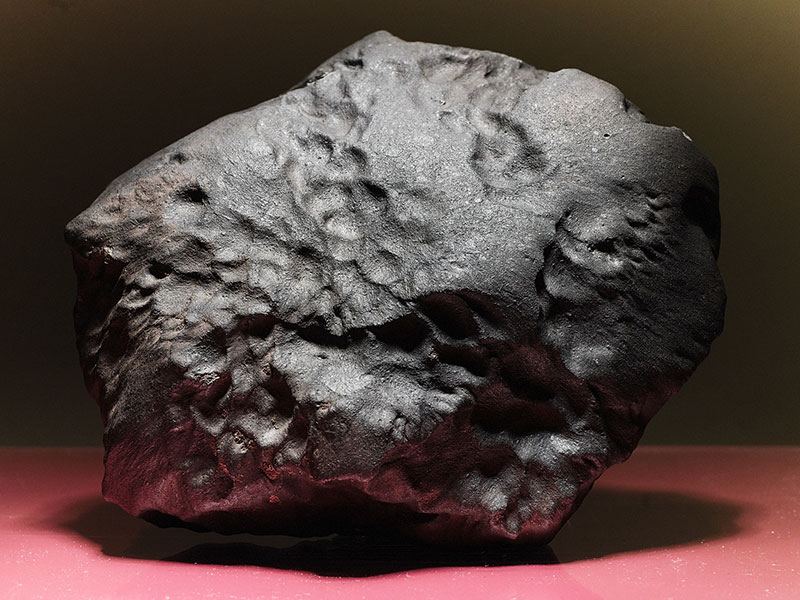Unique “Elmshorn” meteorite now on display at the Hamburg Museum of Nature Hamburg
 Meteorite researcher Dr Stefan Peters sees the ‘Elmshorn’ meteorite as an extraordinary addition to the mineralogical collection at the Museum der Natur Hamburg. ‘Elmshorn’ contributes significantly to our understanding of the early solar system. © LIB, B. Pichelmann
Meteorite researcher Dr Stefan Peters sees the ‘Elmshorn’ meteorite as an extraordinary addition to the mineralogical collection at the Museum der Natur Hamburg. ‘Elmshorn’ contributes significantly to our understanding of the early solar system. © LIB, B. Pichelmann
A meteorite of extraordinary significance has found its place in the Hamburg Museum of Nature. The “Elmshorn” meteorite, which fell from the sky near Hamburg on April 25, 2023, holds both scientific and cultural-historical importance. Weighing 3.7 kilograms, it is the largest intact main mass of a meteorite recovered in Germany over the past century. Officially known as “Elmshorn,” this remarkable specimen will be presented in the mineralogical exhibition at the Museum der Natur Hamburg, exactly one year after its fall, together with the story of its cosmic origin and discovery.
Video recording of the meteorite collapse:
Audio recording of the meteorite collapse:
Dr. Stefan Peters, Head of Mineralogy at the Museum der Natur Hamburg, expresses enthusiasm: This meteorite is a valuable addition to our museum. ‘Elmshorn’ significantly enhances our understanding of the early solar system and enriches our collection. It’s the world’s first mixed-rock meteorite composed of these two particular asteroids. The comprehensive documentation of the fall also writes a piece of North German history. It is a great success that we can present such a historic object to the public just a few kilometers from the impact site.”
Science Senator Katharina Fegebank adds: “With the ‘Elmshorn’ meteorite, a piece of science fell from the sky that one can touch. It gives us new and fascinating insights into the origin of our solar system. And the cosmic find also shows how quickly and precisely scientific findings can be obtained. I am thrilled that this unique find is now accessible to all curious and science-loving Hamburg residents at the Museum of Nature.”
After the International Meteoritical Society officially recognized the object and named it “Elmshorn,” the Leibniz Institute for the Analysis of Biodiversity Change successfully acquired the meteorite for the Museum of Nature with generous support from the Kulturstiftung der Länder (Cultural Foundation of the Federal States). Prof. Dr. Frank Druffner, Deputy Secretary General of the Kulturstiftung der Länder: ‘The “Elmshorn” meteorite fall, which is unique in many respects, may provide new insights into our understanding of the early solar system. I am delighted that, with the support of the Kulturstiftung der Länder, it has been possible to secure these valuable natural history artefacts for science and make them accessible to the public in the region where they were found.’
The meteorite fell onto private property in Elmshorn, Schleswig-Holstein, a mere 30 kilometers from the Museum of Nature Hamburg. The documentation of its fall is truly unique in Germany: a surveillance camera captured the acoustic impact. Just before impact, as the rock hurtled through Earth’s atmosphere, a luminous meteor phenomenon was visible in the sky over northern Germany and the Netherlands. Upon impact, the meteorite left a crater approximately 40 centimeters deep. These captivating images of the meteorite’s atmospheric journey were captured by a meteor camera from the AllSky7 network in Bremerhaven.
A team of researchers, including museum director Stefan Peters from the Leibniz Institute for the Analysis of Biodiversity Change (LIB), used mineralogical and geochemical analyses to discover that the meteorite contains debris from at least two different asteroids. From this, they concluded that two asteroids had apparently collided and been destroyed on their orbits around the Sun. Immediately after the collision, fragments from the interior and surface of the two asteroids mixed and merged together to form the parent body of the “Elmshorn” meteorite.
The history of the Elmshorn meteorite thus stretches back an impressive 4.5 billion years to the very beginnings of our solar system. Elmshorn belongs to a group of meteorites called chondrites. Chondrites are meteorites that originate from asteroids with similar chemical compositions as the Sun. Such asteroids formed from tiny dust grains and most of them eventually coalesced into rocky planets like our Earth. Some asteroids, however, persisted and continue to orbit the Sun today between Mars and Jupiter. They are the parent bodies of our meteorites.
“The meteorite has stored valuable information about a major collision between two asteroids,” says Stefan Peters enthusiastically. “It bridges two distinct groups of meteorites, some of which are currently falling from the sky worldwide. But this is the first time that we’ve identified a mixed rock originating from these two specific asteroids. “We already had materials from both parent bodies in our collection, and now we have a rock that features materials from both of them at the same time. This is a great addition to our collection.”
The Museum of Nature Hamburg has a large meteorite collection with ca. 1000 specimens, including meteorites from Mars and an impressive 424-kilogram iron meteorite. These pieces were found at various locations worldwide, and include several meteorites found in Germany.
The “Elmshorn” meteorite will be presented to the general public for the first time during the Long Night of Museums on April 27.
Contact:
Leibniz Institute for the Analysis of Biodiversity Change (LIB)
Museum of Nature Hamburg – Mineralogy
Dr. Stefan Peters
Head of Mineralogy
s.peters@leibniz-lib.de



